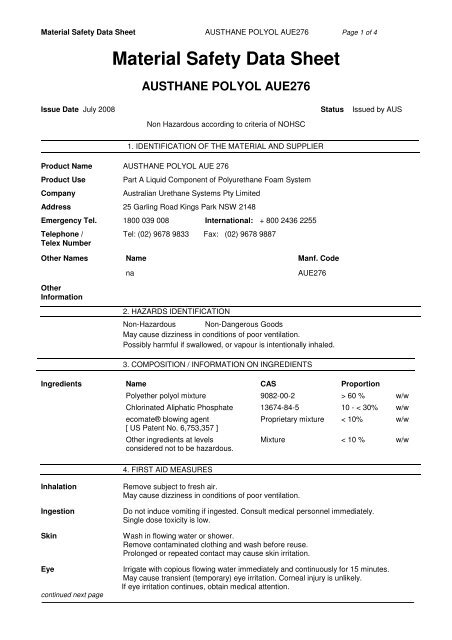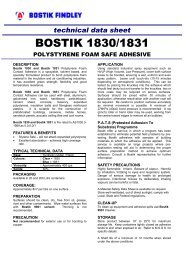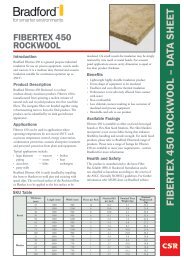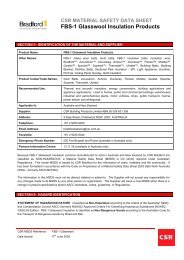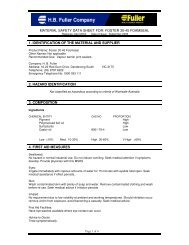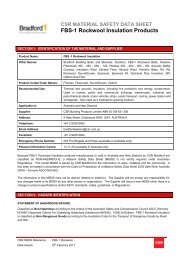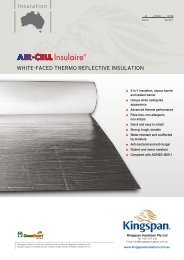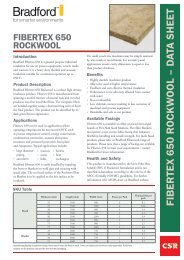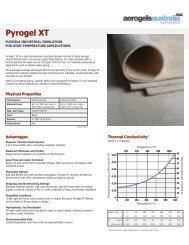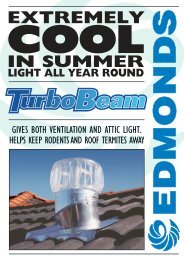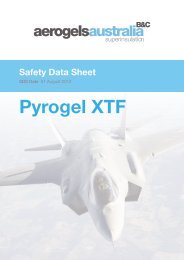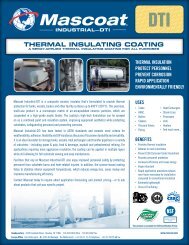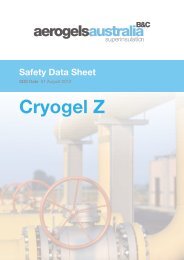Material Safety Data Sheet - Insulation Industries
Material Safety Data Sheet - Insulation Industries
Material Safety Data Sheet - Insulation Industries
Create successful ePaper yourself
Turn your PDF publications into a flip-book with our unique Google optimized e-Paper software.
<strong>Material</strong> <strong>Safety</strong> <strong>Data</strong> <strong>Sheet</strong> AUSTHANE POLYOL AUE276 Page 1 of 4<br />
<br />
<br />
Issue Date July 2008<br />
<strong>Material</strong> <strong>Safety</strong> <strong>Data</strong> <strong>Sheet</strong><br />
AUSTHANE POLYOL AUE276<br />
Non Hazardous according to criteria of NOHSC<br />
Status Issued by AUS<br />
1. IDENTIFICATION OF THE MATERIAL AND SUPPLIER<br />
Product Name AUSTHANE POLYOL AUE 276<br />
Product Use<br />
Company<br />
Part A Liquid Component of Polyurethane Foam System<br />
Australian Urethane Systems Pty Limited<br />
Address 25 Garling Road Kings Park NSW 2148<br />
Emergency Tel. 1800 039 008 International: + 800 2436 2255<br />
Telephone / Tel: (02) 9678 9833 Fax: (02) 9678 9887<br />
Telex Number<br />
Other Names Name Manf. Code<br />
na<br />
AUE276<br />
Other<br />
Information<br />
2. HAZARDS IDENTIFICATION<br />
Non-Hazardous Non-Dangerous Goods<br />
May cause dizziness in conditions of poor ventilation.<br />
Possibly harmful if swallowed, or vapour is intentionally inhaled.<br />
3. COMPOSITION / INFORMATION ON INGREDIENTS<br />
Ingredients Name CAS Proportion<br />
Polyether polyol mixture 9082-00-2 > 60 % w/w<br />
Chlorinated Aliphatic Phosphate 13674-84-5 10 - < 30% w/w<br />
ecomate® blowing agent<br />
[ US Patent No. 6,753,357 ]<br />
Other ingredients at levels<br />
considered not to be hazardous.<br />
4. FIRST AID MEASURES<br />
Proprietary mixture < 10% w/w<br />
Mixture < 10 % w/w<br />
Inhalation<br />
Ingestion<br />
Skin<br />
Eye<br />
continued next page<br />
Remove subject to fresh air.<br />
May cause dizziness in conditions of poor ventilation.<br />
Do not induce vomiting if ingested. Consult medical personnel immediately.<br />
Single dose toxicity is low.<br />
Wash in flowing water or shower.<br />
Remove contaminated clothing and wash before reuse.<br />
Prolonged or repeated contact may cause skin irritation.<br />
Irrigate with copious flowing water immediately and continuously for 15 minutes.<br />
May cause transient (temporary) eye irritation. Corneal injury is unlikely.<br />
If eye irritation continues, obtain medical attention.
<strong>Material</strong> <strong>Safety</strong> <strong>Data</strong> <strong>Sheet</strong> AUSTHANE POLYOL AUE276 Page 2 of 4<br />
First Aid Facilities<br />
Advice to Doctor<br />
Eye wash and normal washroom facilities.<br />
No specific antidote. Supportive care. May be harmful if swallowed.<br />
5. FIRE FIGHTING MEASURES<br />
Extinguishing<br />
Media<br />
Specific<br />
Methods<br />
Specific<br />
Hazards<br />
Foam, alcohol resistant foam, carbon dioxide, dry chemical and water fog.<br />
May decompose in heat / fire releasing products of greater hazard.<br />
Keep containers cool with water spray. Fire fighters to wear positive pressure selfcontained<br />
breathing apparatus, safety glasses, boots, gloves and coveralls.<br />
Contains a low Boiling Point [31.5°C] liquid. High temperatures may cause rupture<br />
of sealed containers. Stable under normal handling and storage conditions.<br />
Incompatible with oxidising materials and strong acids.<br />
6. ACCIDENTAL RELEASE MEASURES<br />
Eliminate ignition sources. Immediately contain any liquid spillage with spill containment<br />
equipment, dikes of soil / sand / or inert absorbent.<br />
Only allow personnel wearing full protective safety equipment including respiratory<br />
equipment, gloves, safety glasses and coveralls to be involved in clean-up.<br />
Avoid skin and eye contact. Do not breathe vapours directly.<br />
Absorb spilled material with inert absorbent (sand, vermiculite etc.) and put in<br />
closed containers for disposal.<br />
Do not permit to contaminate waterways, sewers or drains.<br />
Residual contamination from spills can be cleaned up with a dilute detergent / water solution.<br />
7. HANDLING AND STORAGE<br />
Handling<br />
Storage<br />
Wear full protective safety clothing - impervious PVC gloves, <strong>Safety</strong> goggles or<br />
Face Mask and Coveralls and respiratory equipment.<br />
Take care when opening drum / container seals in > 30°C temperature conditions or if the<br />
container has become pressurised.<br />
Ensure good general ventilation when opening drums / handling the product.<br />
Store in a cool, well ventilated area.<br />
Store away from oxidising agents and sources of heat.<br />
Keep containers closed at all times.<br />
8. EXPOSURE CONTROLS / PERSONAL PROTECTION<br />
Exposure Limits<br />
Use only in a well ventilated areas<br />
Personal<br />
Wear full protective safety clothing - impervious PVC gloves, safety goggles or<br />
Protective full face mask, coveralls and respiratory protection. .<br />
Equipment<br />
Always wash hands before smoking, eating, drinking or using toilet.<br />
Wash contaminated clothing and other protective equipment before storing or re-using.
<strong>Material</strong> <strong>Safety</strong> <strong>Data</strong> <strong>Sheet</strong> AUSTHANE POLYOL AUE276 Page 3 of 4<br />
9. PHYSICAL AND CHEMICAL PROPERTIES<br />
Appearance Clear amber liquid<br />
Odour<br />
Mild pungent odour<br />
pH<br />
Not applicable<br />
Vapour Pressure < 50 mm Hg @ 25°C)<br />
Vapour Density > 1<br />
[Air = 1]<br />
Melting Point Not applicable<br />
Boiling Point Decomposes at elevated temperatures<br />
Solubility in Water Slightly soluble<br />
Solubility in Slightly soluble<br />
Organic Solvents<br />
Specific Gravity 1.08 g/ml (25°C)<br />
[Water = 1]<br />
Flashpoint<br />
> 35°C (COC, ASTM D-92)<br />
Flammability Does not sustain combustion.<br />
10. STABILITY AND REACTIVITY<br />
Stability<br />
Hazardous<br />
Polymerisation<br />
<strong>Material</strong>s to Avoid<br />
Stable<br />
Will not occur.<br />
Reacts with oxidising agents and isocyanates.<br />
11. TOXICOLOGICAL INFORMATION<br />
Toxicology<br />
Information<br />
Inhalation<br />
Ingestion<br />
Skin<br />
Eye<br />
Chronic Effects<br />
No information available for this Polyol blend.<br />
Information for Component CAS # 13674-84-5 [ 10 - < 30% w/w ]<br />
Acute Oral LD 50 [rat] > 1000 - 3000 mg/kg bw<br />
Acute Inhalation LC 50 [rat] 4 hrs > 4.6 mg/l<br />
Acute Dermal LD 50 [rat] > 5000 mg/kg bw<br />
Harmful if inhaled. Inhalation of vapour may cause dizziness in conditions of poor ventilation.<br />
Harmful if swallowed. The hazard of aspirating material into the lungs is greater than the<br />
hazard associated with allowing material to progress through the intestinal tract.<br />
Prolonged or repeated contact may cause skin irritation.<br />
Will cause transient (temporary) eye irritation. Corneal injury is unlikely.<br />
Product is harmful if swallowed or if vapour is intentionally inhaled.<br />
Prolonged or repeated contact may cause skin irritation.<br />
12. ECOLOGICAL INFORMATION<br />
Avoid contaminating waterways. No specific data available for Polyol blend.<br />
Information for Component CAS # 13674-84-5 [ 10 - < 30% w/w ]<br />
Fish, fresh water – Brachydanio rerio: 96 hrs / LC 50 56.2 mg/l<br />
Daphnia magna [Crustacea] 48 hrs / EC 50 65 – 335 mg/l<br />
Environmental<br />
Fate<br />
No data available.
<strong>Material</strong> <strong>Safety</strong> <strong>Data</strong> <strong>Sheet</strong> AUSTHANE POLYOL AUE276 Page 4 of 4<br />
13. DISPOSAL CONSIDERATIONS<br />
Liquid Residues<br />
Containers<br />
Small quantities < 20 kgs can be disposed of by reaction with PMDI Isocyanate in open top<br />
containers.<br />
Wear full protective safety equipment as detailed in SECTION 8 of this MSDS and the<br />
MSDS for the Isocyanate component.<br />
Mix in well ventilated area, in < 3 kg mix quantities. Allow at least 30 minutes cooling time<br />
between each mix to allow the reacted foam to cool before the next mix. After reaction into<br />
a solid foam, dispose of in solid waste.<br />
For larger quantities, normally suitable for incineration by an approved agent.<br />
Drain containers to remove ullage material. Rinse the container with dilute<br />
detergent / water solution. Dispose of cleaned container appropriately.<br />
Collect the rinse solution in an open container and absorb onto an inert absorbent<br />
material. Allow water to evaporate and dispose of in solid waste.<br />
Do not weld or use a cutting torch on or near drums, even if drained. Uncontaminated<br />
empty drums will contain residual material which may decompose to emit toxic or<br />
irritating fumes if burned or cut with a steel cutting torch.<br />
14. TRANSPORT INFORMATION<br />
This product is not classified in the Australian Dangerous Goods Code either by<br />
reference to a specific substance name or a generic substance name or group in<br />
accordance with regulations applicable to combustible liquids.<br />
UN Number<br />
Proper Shipping<br />
Name<br />
DG Class<br />
Hazchem Code<br />
Packaging Group<br />
EPG Number<br />
IERG Number<br />
None allocated<br />
Not applicable<br />
Not relevant<br />
Not relevant<br />
Not relevant<br />
Nil<br />
Nil<br />
15. REGULATORY INFORMATION<br />
Risk Phrase<br />
<strong>Safety</strong> Phrase<br />
Poisons<br />
Schedule<br />
Hazard Category<br />
Nil<br />
Nil<br />
None allocated<br />
Non hazardous<br />
Issue Date July 2008<br />
16. OTHER INFORMATION<br />
Copyright: Australian Urethane Systems Pty Ltd<br />
Information provided has been prepared in good faith and believed to be correct. Australian Urethane Systems make no warranty<br />
either express or implied as to completeness, accuracy thereof, misuse or misinterpretation of this information.<br />
END OF MSDS
<strong>Material</strong> <strong>Safety</strong> <strong>Data</strong> <strong>Sheet</strong> AUSTHANE ECOISO-GP ISOCYANATE Page 1 of 6<br />
<br />
<br />
Issue Date May 2008<br />
<strong>Material</strong> <strong>Safety</strong> <strong>Data</strong> <strong>Sheet</strong><br />
AUSTHANE ECOISO-GP ISOCYANATE<br />
Hazardous according to criteria of NOHSC<br />
Status Issued by AUS<br />
1. IDENTIFICATION OF THE MATERIAL AND SUPPLIER<br />
Product Name<br />
Product Use<br />
Company<br />
AUSTHANE ECOISO-GP ISOCYANATE<br />
Part B Liquid Component of ecomate based Polyurethane Foam System<br />
Australian Urethane Systems Pty Limited<br />
Address 25 Garling Road Kings Park NSW 2148<br />
Emergency Tel. 1800 039 008 International: + 800 2436 2255<br />
Telephone / Tel: (02) 9678 9833 Fax: (02) 9678 9887<br />
Telex Number<br />
Other Names Name Manf. Code<br />
Other Information<br />
ECOISO-GP, Polymeric MDI,<br />
Diphenylmethane-4,4-diisocyanate<br />
2. HAZARDS IDENTIFICATION<br />
ECOISO-GP<br />
Classified as hazardous according to criteria of NOHSC.<br />
HAZARDOUS SUBSTANCE<br />
NON DANGEROUS GOODS.<br />
Risk Phrases: R 20 Harmful by inhalation.<br />
R 36/37/38<br />
R 42/43<br />
Irritating to eyes / irritating to respiratory system / irritating to<br />
skin.<br />
May cause sensitisation by inhalation / may cause<br />
sensitisation by skin contact.<br />
<strong>Safety</strong> Phrases: S 26 In case of contact with eyes, rinse immediately with<br />
plenty of water and contact medical advice or contact a<br />
Poisons Information Centre.<br />
S 28<br />
S 38<br />
S 45<br />
After contact with skin, wash immediately with water<br />
and soap - warm, soapy water, if available.<br />
In case of insufficient ventilation, wear suitable respiratory<br />
equipment.<br />
In case of accident or if you feel unwell, contact a doctor or<br />
Poisons Information Centre immediately. (show the label if<br />
possible).<br />
3. COMPOSITION / INFORMATION ON INGREDIENTS<br />
Ingredients Name CAS Proportion<br />
Polymethylene polyphenylisocyanate<br />
[ Diphenylmethane diisocyanate (isomers<br />
and homologues)]<br />
9016-87-9 > 60 % w/w<br />
Proprietary Additive NIL < 10% w/w
<strong>Material</strong> <strong>Safety</strong> <strong>Data</strong> <strong>Sheet</strong> AUSTHANE ECOISO-GP ISOCYANATE Page 2 of 6<br />
4. FIRST AID MEASURES<br />
Inhalation<br />
Ingestion<br />
Skin<br />
Eye<br />
First Aid Facilities<br />
Advice to Doctor<br />
May cause respiratory sensitisation in susceptible individuals. If any breathing difficulty<br />
occurs, keep patient calm, remove to fresh air, and if allergic reaction occurs seek medical<br />
attention.<br />
MDI concentrations below the exposure standards may cause allergic respiratory reactions<br />
in individuals already sensitised. Symptoms may include coughing, difficult breathing and a<br />
feeling of tightness in the chest. Effects may be delayed.<br />
Immediately rinse mouth and drink plenty of water. Do not induce vomiting.<br />
Ingestion of this product causes vomiting, nausea and abdominal pain.<br />
Single dose oral toxicity is considered to be extremely low. No hazards anticipated from<br />
swallowing small amounts incidental to normal handling operations.<br />
Avoid contact with skin. Wash immediately with plenty of warm water and soap.<br />
Remove any contaminated clothing.<br />
Prolonged or repeated exposure may cause skin irritation. May stain the skin. Skin contact<br />
may result in allergic skin reactions or respiratory sensitisation but is not expected to result in<br />
absorption of amounts sufficient to cause other adverse effects.<br />
Irrigate with copious flowing water immediately and continuously for 15 minutes.<br />
May cause slight transient (temporary) eye irritation. Corneal injury is unlikely.<br />
Eye wash and normal washroom facilities.<br />
No specific antidote. Supportive care. Symptoms may appear later.<br />
5. FIRE FIGHTING MEASURES<br />
Extinguishing<br />
Media<br />
Hazards from<br />
Combustion<br />
Products<br />
Specific<br />
Precautions<br />
Specific<br />
Hazards<br />
Foam, alcohol resistant foam, carbon dioxide and dry chemical.<br />
Keep containers cool with water spray<br />
Produces oxides of carbon and nitrogen on combustion. May produce traces of hydrogen<br />
cyanide. May decompose in heat/fire releasing products of greater hazard.<br />
Fire fighters to wear positive pressure self-contained breathing apparatus, safety glasses,<br />
boots, gloves and coveralls.<br />
Contain any run-off by diking to prevent entry into sewers, drains or water systems.<br />
Isocyanate vapour and mist, carbon dioxide, carbon monoxide, nitrogen oxides and<br />
traces of hydrogen cyanide.<br />
6. ACCIDENTAL RELEASE MEASURES<br />
Evacuate and ventilate spill area. Contain spill by diking, to prevent entry into sewers,<br />
drains or water systems.<br />
Wear full protective equipment including respiratory equipment during clean up. Avoid skin<br />
and eye contact. Wear gloves, safety glasses and coveralls. Avoid breathing vapours<br />
directly. Refer to Section 8 of this MSDS for Exposure Standards.<br />
For small spills, < 20 litres, absorb spilled material with inert absorbent (sand, vermiculite<br />
etc.) and put into open top containers. Do not permit to contaminate waterways, sewers or<br />
drains. Absorb the Isocyanate with sawdust or other absorbent and shovel into open top<br />
containers - do not make pressure tight. Transport to well-ventilated area (outside) and<br />
treat with neutralising solution consisting of a mixture of 90 % water, 5 % detergent and<br />
5 % concentrated ammonium hydroxide. Add about 10 parts of the neutralising solution per<br />
part of Isocyanate with mixing.<br />
Allow to stand for 48 to 72 hours letting any evolved carbon dioxide escape. Do not seal.<br />
For large amounts, > 20 litres, either pump product into or collect in suitable containers<br />
and transfer into clean closed head type drums. In case of any contamination, do not<br />
make pressure tight.<br />
Residual contamination from spills can be cleaned up with the neutralising solution - a<br />
mixture of 90% water, 5% industrial grade detergent and 5% concentrated ammonium<br />
hydroxide.
<strong>Material</strong> <strong>Safety</strong> <strong>Data</strong> <strong>Sheet</strong> AUSTHANE ECOISO-GP ISOCYANATE Page 3 of 6<br />
7. HANDLING AND STORAGE<br />
Handling<br />
Storage<br />
Wear the protective equipment as set out below when handling this product.<br />
Excessive exposure may cause irritation of the eyes, upper respiratory tract and lungs.<br />
Impaired lung function (decreased ventilatory capacity) has been associated with over<br />
exposure to Isocyanates.<br />
At room temperature, vapours are minimal due to low vapour pressure. Fresh air should be<br />
directed at personnel handling / using the product.<br />
In any applications/operations where isocyanate aerosol or vapour concentrations are<br />
produced , exhaust ventilation must be provided to meet Exposure Standards. These<br />
include activities in which the material is heated, sprayed or otherwise mechanically<br />
dispersed such as drumming, venting or pumping.<br />
Wear industrial safety clothing, as per details below:<br />
Impervious PVC gloves - refer to<br />
AS 2161: Industrial <strong>Safety</strong> Gloves and Mittens<br />
<strong>Safety</strong> goggles or Face Mask - refer to<br />
AS 1336: Recommended practices for eye protection in the industrial environment<br />
AS/NZS 1337: Eye protectors for industrial application<br />
Respiratory Protection - refer to<br />
AS/NZS 1715: Selection, use and maintenance of respiratory protective devices<br />
and Coveralls.<br />
Keep containers closed at all times.<br />
Store indoors at 15 to 25°C in original, unopened containers. Protect from atmospheric<br />
moisture. Replace outage with inert Dry Nitrogen Gas. Avoid product temperatures<br />
above 50°C and below 5°C. At temperatures below 5°C crystallisation may occur.<br />
Crystallised product can be melted by heating overnight to 60-70°C.<br />
Store away from oxidising agents, acids, alkali, amines, direct sunlight or any source of<br />
ignition or heat.<br />
8. EXPOSURE CONTROLS / PERSONAL PROTECTION<br />
Exposure Limits Workplace Exposure Standard (ES) for Isocyanates, all (as –NCO): #<br />
TWA = 0.02 mg / m³<br />
STEL = 0.07 mg / m³<br />
Sen.<br />
[Time weighted average exposure]<br />
[Short term exposure limit]<br />
[Sensitiser]<br />
# Exposure Standard for Atmospheric Contaminants in the Occupational<br />
Environment, published by Worksafe Australia.<br />
Engineering<br />
Controls<br />
Protective<br />
Equipment<br />
Personal<br />
Use only in well ventilated area. Maintain air concentrations below Exposure Standards.<br />
Wear industrial safety clothing, as per details below. Always wash hands before smoking,<br />
eating, drinking or using toilet. Wash contaminated clothing and other protective<br />
equipment before storing or re-using.<br />
Impervious PVC gloves - refer to<br />
AS 2161: Industrial <strong>Safety</strong> Gloves and Mittens<br />
<strong>Safety</strong> goggles or Face Mask - refer to<br />
AS 1336: Recommended practices for eye protection in the industrial environment<br />
AS/NZS 1337: Eye protectors for industrial application<br />
Respiratory Protection - refer to<br />
AS/NZS 1715: Selection, use and maintenance of respiratory protective devices<br />
Clothing – refer to<br />
AS/NZS 2210: Occupational protective footwear. AS 2919: Industrial clothing
<strong>Material</strong> <strong>Safety</strong> <strong>Data</strong> <strong>Sheet</strong> AUSTHANE ECOISO-GP ISOCYANATE Page 4 of 6<br />
9. PHYSICAL AND CHEMICAL PROPERTIES<br />
Appearance Clear dark amber liquid<br />
Odour<br />
Mild musty odour<br />
pH<br />
Not applicable<br />
Vapour Pressure < 0.01 Pascals (25°C)<br />
Vapour Density > 1<br />
[Air = 1]<br />
Melting Point < 0°C<br />
Boiling Point 200°C @ 1 atm<br />
Solubility in Water Insoluble – reacts slowly with water<br />
Solubility in Slightly soluble<br />
Organic Solvents<br />
Specific Gravity 1.22 g/ml (25°C)<br />
[Water = 1]<br />
Flashpoint > 204°C (DIN 51758)<br />
Ignition Temperature > 600°C<br />
Flammability Non flammable<br />
10. STABILITY AND REACTIVITY<br />
Stability Stable. Thermal decomposition > 230°C<br />
Hazardous<br />
Polymerisation<br />
<strong>Material</strong>s to Avoid<br />
Hazards from<br />
Combustion<br />
Products<br />
Exothermic reaction with amines and alcohols. Reacts with water forming Carbon<br />
Dioxide gas, if in closed containers this may cause sufficient pressure build-up to burst<br />
containers.<br />
Water, acids, alkalis, alcohols, and metal compounds. Avoid water as it reacts to form<br />
heat and carbon dioxide. Enough heat and pressure can be produced to rupture a<br />
closed container. The reaction with water is slow at temperatures less than 49 o C, but<br />
accelerated at higher temperature and in the presence of the above mentioned<br />
materials. Some reactions are violent.<br />
Produces oxides of carbon and nitrogen on combustion. May produce traces of hydrogen<br />
cyanide. May decompose in heat/fire releasing products of greater hazard.<br />
11. TOXICOLOGICAL INFORMATION<br />
Inhalation<br />
Ingestion<br />
Skin<br />
Eye<br />
Chronic Effects<br />
continued next page<br />
MDI concentrations below the exposure standards may cause allergic respiratory reactions<br />
in individuals already sensitised. Symptoms may include coughing, difficult breathing and a<br />
feeling of tightness in the chest. Effects may be delayed.<br />
LC 50 inhalation, rat 490 mg aerosol / m³, 4 hr exposure. Concentration of the saturated<br />
vapour of Diphenylmethane-4,4-diisocyanate (MDI0 @ 25°C – 0.09 mg/m³.<br />
Ingestion of this product causes vomiting, nausea and abdominal pain.<br />
Single dose oral toxicity is considered to be extremely low.<br />
No hazards anticipated from swallowing small amounts incidental to normal handling<br />
operations.<br />
LD 50 oral / rat - > 10,000 mg/kg<br />
Prolonged or repeated exposure may cause skin irritation. May stain the skin. Skin contact<br />
may result in allergic skin reactions or respiratory sensitisation but is not expected to result<br />
in absorption of amounts sufficient to cause other adverse effects.<br />
LD 50 dermal / rabbits > 5,000 mg/kg.<br />
May cause slight transient (temporary) eye irritation. Corneal injury is unlikely.<br />
Systemic (Other Target Organ) Effects<br />
Tissue injury in the upper respiratory tract and lungs has been observed in laboratory<br />
animals after repeated excessive exposures to MDI / Polymeric, MDI aerosols.
<strong>Material</strong> <strong>Safety</strong> <strong>Data</strong> <strong>Sheet</strong> AUSTHANE ECOISO-GP ISOCYANATE Page 5 of 6<br />
Mutagenicity:<br />
Cancer Information<br />
Lung tumors have been observed in laboratory animals exposed to aerosol droplets of<br />
MDI / Polymeric MDI at 6mg/m 3 for their lifetime. Tumours occurred concurrently with<br />
respiratory irritation and lung injury. Only irritation was noted at the lower concentrations<br />
of 0.2 and 0.1 mg / m³.<br />
Current Exposure Standards are expected to protect against these effects.<br />
Teratology (Birth Defects)<br />
In laboratory animals, Polymeric MDI did not produce birth defects; other fetal effects<br />
occurred only at high doses, which were toxic to the mother.<br />
Mutagenicity data on MDI are inconclusive. MDI was weakly positive in some in vitro (test<br />
tube) studies; other in-vitro studies were negative. A mutagenicity study in animals was<br />
negative.<br />
12. ECOLOGICAL INFORMATION<br />
Do not allow to escape into waters, wastewater or soil.<br />
Movement<br />
& Partitioning<br />
Degradation<br />
& Transportation<br />
Movement in the environment is expected to be limited by the formation of insoluble<br />
polymers.<br />
Biodegradability: 0%, 28 days. Immiscible in water. Reaction with water at interface<br />
produces Carbon Dioxide and forms an insoluble and high melting point solid – polyurea.<br />
Degradation is expected in the atmospheric environment.<br />
Ecotoxicity Toxicity to fish: LC 0 (96 h) > 100 mg/l - Brachydanio rerio<br />
Aquatic invertebrates: EC 50 (24 h) > 750 mg/l – Daphnia pulex<br />
13. DISPOSAL CONSIDERATIONS<br />
Liquid Residues<br />
Small quantities < 20 kgs can be disposed of by reaction with a suitable Polyol blend.<br />
Mix one part of AUSTHANE ECOISO-GP Isocyanate with one part by volume of the<br />
selected polyol blend.<br />
Mix in open top container in well ventilated area, in < 5 kg mix quantities.<br />
Allow at least 30 minutes cooling time between each mix to allow the reacted foam to cool<br />
before the next mix.<br />
After reaction into a solid foam product, dispose of in solid waste.<br />
For larger quantities, normally suitable for incineration by an approved agent.<br />
Containers<br />
Drain containers to remove ullage material. Rinse the container with a neutralising solution<br />
consisting of a mixture of 90% water, 5% industrial grade detergent and 5% concentrated<br />
ammonium hydroxide.<br />
Allow neutralising solution to react for 48 hours in unsealed containers in external area.<br />
Absorb the rinse liquid into inert absorbent and hold in open containers to allow evaporation<br />
of water, then dispose of in solid waste.<br />
Dispose of cleaned container appropriately.<br />
14. TRANSPORT INFORMATION<br />
UN Number<br />
Proper Shipping<br />
Name<br />
DG Class<br />
Hazchem Code<br />
Packaging Group<br />
EPG Number<br />
IERG Number<br />
This product is not classified in the Australian Dangerous Goods Code either by<br />
reference to a specific substance name or a generic substance name or group in<br />
accordance with regulations applicable to combustible liquids.<br />
None allocated<br />
Not applicable<br />
Not relevant<br />
Not relevant<br />
Not relevant<br />
Nil<br />
Nil
<strong>Material</strong> <strong>Safety</strong> <strong>Data</strong> <strong>Sheet</strong> AUSTHANE ECOISO-GP ISOCYANATE Page 6 of 6<br />
15. REGULATORY INFORMATION<br />
Poisons Class 6<br />
Schedule<br />
Hazard Category<br />
Other CAS Numbers<br />
/ Products<br />
Symbol: Xn. Harmful. Irritant. Sensitiser.<br />
Diphenylmethane – 4,4’ – di-isocyanate 101-68-8<br />
Methylenediphenyl diisocyanate 26447-40-5<br />
Issue Date May 2008<br />
16. OTHER INFORMATION<br />
References Worksafe Australia Guide - “ISOCYANATES” - July 1990.<br />
National Occupational Health and <strong>Safety</strong> Commission.<br />
Australian Government Publishing Service Canberra.<br />
Code WAP 90/017 GS O12-1990.<br />
Adopted National Exposure Standards for Atmospheric Contaminants in the<br />
Occupational Environment<br />
NOHSC: 1003 (1995)<br />
Occupational Health and <strong>Safety</strong> Commission.<br />
Copyright: Australian Urethane Systems Pty Ltd<br />
Information provided has been prepared in good faith and believed to be correct. Australian Urethane Systems make no<br />
warranty either express or implied as to completeness, accuracy thereof, misuse or misinterpretation of this information.<br />
END OF MSDS


